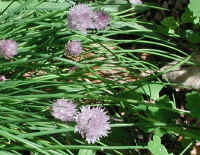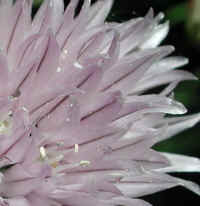 Chives,
Wild (Allium schoenoprasum v. sibiricum)
Chives,
Wild (Allium schoenoprasum v. sibiricum)
Wild Flowers of Sleepy Hollow Lake From All-Creatures.org Art and Photo Journals and Galleries Directory
Dedicated to the Preservation and Restoration of the Whole of Creation: Humans - Animals - Environment
"And God saw all that He had made, and behold, it was very good.
And there was evening and there was morning, the sixth day" (Genesis 1:31)
Chives, Wild (Allium schoenoprasum v. sibiricum)
Table of Contents

(Chives, Wild (Allium schoenoprasum v. sibiricum) - 01)
Wild chives are one of the first appearing wildflowers in the spring, often
appearing as tufts of grass. The flowers begin to develop several weeks
later. This particular cluster of wild chives seems to have fallen over
during a heavy rain. The literature says that wild chives can grow to
heights of two feet, but the ones we've seen were not much over one foot in height.

(Chives, Wild (Allium schoenoprasum v. sibiricum) - 01a)
The leaves of the wild chives are long and narrow and come to a point at the
top. In cross-section, the leaves are hollow and oval shaped. The
younger leaves are flavorful and and make a nice addition to a salad or a dip.

(Chives, Wild (Allium schoenoprasum v. sibiricum) - 02)
The flower clusters of wild chives develop at the tip of stalks that resemble
the leaves. They are a member of the onion family (Allium), and as the
name "sibiricum" implies, wild chives were first described in Siberia.

(Chives, Wild (Allium schoenoprasum v. sibiricum) - 03)
Wild chives grow from slender bulbs that are about one inch in length.
They seem to prefer moist well drained soil, but will grow even in clay soils.
Though we have seen wild chives growing in woods, we haven't observed any
flowering of plants growing in shady places. This particular plant was
growing in bright sunlight. We could not identify the dark speck on the
flower cluster. The flower clusters are about 3/4 to 1 inch across.

(Chives, Wild (Allium schoenoprasum v. sibiricum) - 03a)
In this photo we get a closer look at the individual tiny wild chives flowers.
Each light purple flower has six petals, six stamens, and one pistil. The
stamens and pistil are easy to identify in the flower to the left of the dark speck.

(Chives, Wild (Allium schoenoprasum v. sibiricum) - 03b)
The flowers of the wild chives are so densely packed together that it is hard to
distinguish which petal belongs to which flower.

(Chives, Wild (Allium schoenoprasum v. sibiricum) - 03c)
This is another bee's-eye view of some of the wild chives flowers. There
is a wonderful sense of both peace and awe when we observe the beauty of God's creation.

(Chives, Wild (Allium schoenoprasum v. sibiricum) - 04)
In this bee's-eye look into the bowl of a single wild chives flower, we can
count the six petals.

(Chives, Wild (Allium schoenoprasum v. sibiricum) - 05)
In early spring, the wild chives grow up through last year's fallen leaves.

(Chives, Wild (Allium schoenoprasum v. sibiricum) - 06)
At a distance, wild chives look like a tuft of grass, but upon closer
examination, the tubular stalks can be identified. Also, at this stage of
development, wild chives and garlic look very much alike.

(Chives, Wild (Allium schoenoprasum v. sibiricum) - 06a)
In this photo, we have a closer look at the tubular stalks of the wild chives.

(Chives, Wild (Allium schoenoprasum v. sibiricum) - 07)
This clump of wild chives is in various stages of the blooming process from the
newly developing buds to flowers that are beginning to open.

(Chives, Wild (Allium schoenoprasum v. sibiricum) - 08)
This is another look at some of the wild chives buds and flowers that are just beginning to open.

(Chives, Wild (Allium schoenoprasum v. sibiricum) - 08a)
From our observations, it appears that wild chives do not have separate stems
and leaves, but that any leaf it capable of producing a flower, as can be seen
in the leaf tip of the leaf in the top center of the photo.

(Chives, Wild (Allium schoenoprasum v. sibiricum) - 08b)
This photo gives us a closer look at one of the wild chives flower buds.

(Chives, Wild (Allium schoenoprasum v. sibiricum) - 09)
This wild chives flower cluster is just beginning to open.

(Chives, Wild (Allium schoenoprasum v. sibiricum) - 10)
These wild chives are beginning to bloom.

(Chives, Wild (Allium schoenoprasum v. sibiricum) - 11)
This is a side view of a wild chives flower bud.
| Wild Flowers of SHL: Photo Identification, Common Name, Scientific Name | Art and Photos |

 Presented here are just a few of the countless components of God's creation.
Just as we cannot have human and animal life without water and plants, neither
can we have lasting peace without love and compassion. It is our hope and
prayer that this series will motivate people to live and act in a cruelty-free
manner; that we would no longer hurt or destroy each other, the animals or our
environment.
Presented here are just a few of the countless components of God's creation.
Just as we cannot have human and animal life without water and plants, neither
can we have lasting peace without love and compassion. It is our hope and
prayer that this series will motivate people to live and act in a cruelty-free
manner; that we would no longer hurt or destroy each other, the animals or our
environment.






